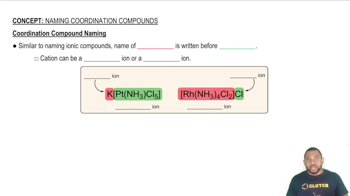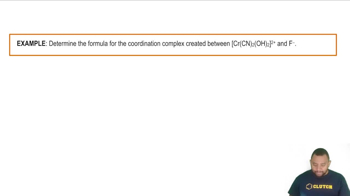Textbook Question
Write the formula for each of the following compounds.
(a) Tetraammineplatinum(II) chloride
(b) Sodium hexacyanoferrate(III)

 Verified step by step guidance
Verified step by step guidance



Write the formula for each of the following compounds.
(a) Tetraammineplatinum(II) chloride
(b) Sodium hexacyanoferrate(III)
Write the formula for each of the following compounds.
(c) Tris(ethylenediamine)platinum(IV) sulfate
(d) Triamminetrithiocyanatorhodium(III)
Write the formula for each of the following compounds.
(a) Diamminesilver(I) nitrate
(b) Potassium diaquadioxalatocobaltate(III)
Which of the following complexes are chiral?
(a) Pt(en)Cl2
(b) cis-[Co(NH3)4Br2]+
(c) cis-[Cr(en)2(H2O)2]3+
(d) [Cr(C2O4)3]3-
Tris(2-aminoethyl)amine, abbreviated tren, is the tetradentate ligand N(CH2CH2NH2)3. Using to represent each of the three NCH2CH2NH2 segments of the ligand, sketch all possible isomers of the octahedral complex [Co(tren)BrCl]+.